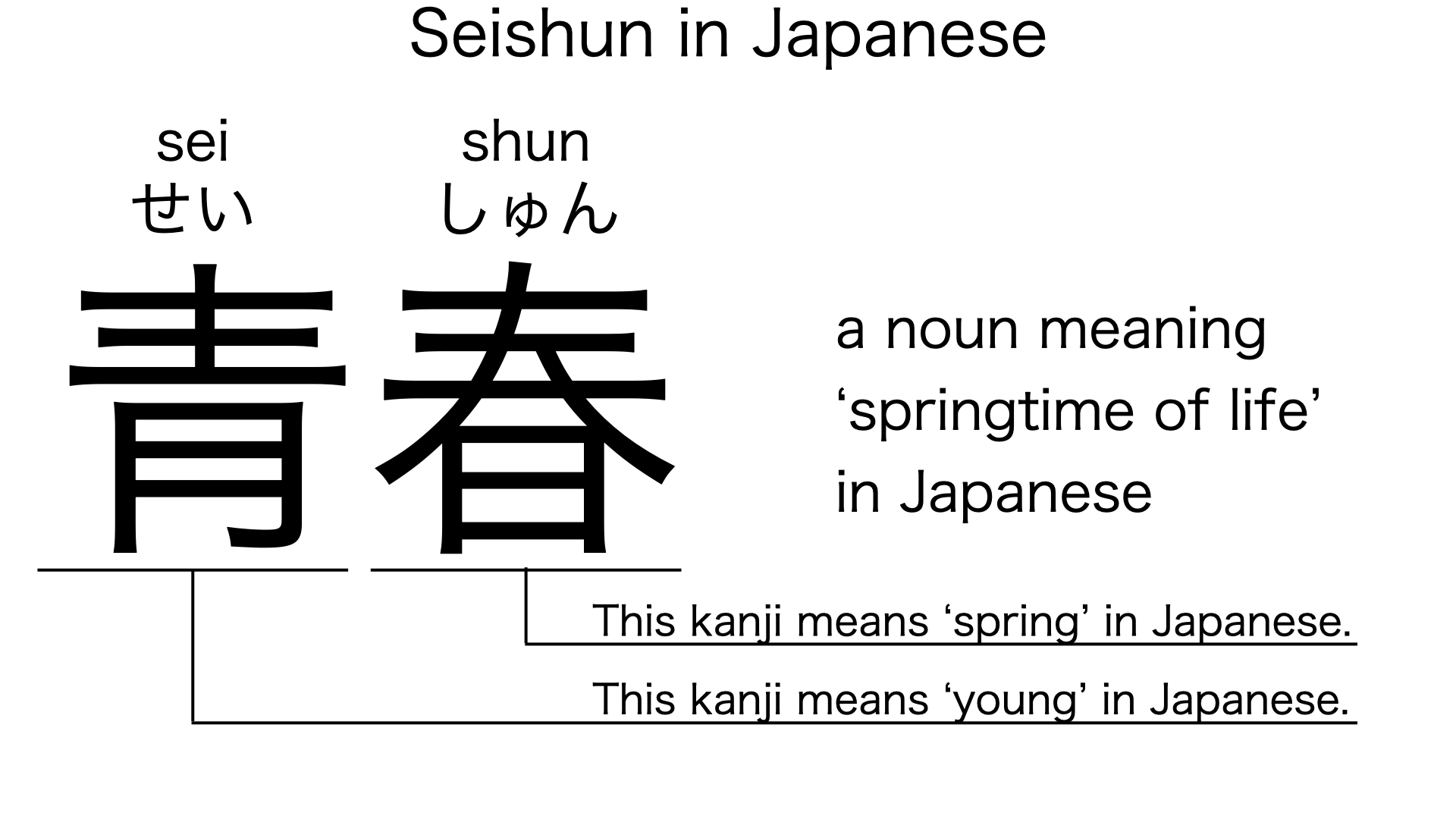What does “seishun” mean in Japanese?
Native speakers say “seishun” often to mean ‘springtime of life’ in Japanese. Perhaps, some Japanese learners know this word as it is sometimes used in Japanese movies, songs, novels, manga, anime, and the like. In this blog post, however, I will explain this word in detail based on its kanji expression. And also, I will explain how to use it through example sentences. My explanations would help Japanese learners understand “seishun” more clearly. Then, let’s get started!
Contents
Definition and meanings of “seishun”
Let me start with the definition and meanings of “seishun”.
- seishun – 青春 (せいしゅん) : a noun meaning ‘springtime of life’, ‘adolescence’, or just ‘youth’ in Japanese.
The definition and meanings are not that difficult, I think. The meanings seem to be based on the same idea. To understand this noun more clearly, however, let me explain its kanji characters in detail, one by one.
What does “seishun” literally mean in Japanese?
The kanji expression of “seishun” consists of the following two kanji characters:
- 青 : a kanji character occasionally used to mean ‘young’ in Japanese.
- 春 : a kanji character often used to mean ‘spring’ in Japanese.
From these two kanji characters, we can understand that “seishun” literally means ‘young spring’ in Japanese. This literal interpretation is not completely in line with the actual meanings, but still understandable, I think. A young time in life can often be considered as springtime of life.

When we meet new kanji expressions, we should check their kanji characters in detail to understand their meanings clearly and deeply. In many cases, kanji characters tell us a lot about the meanings of the expressions they form. Actually, here, we could get the better understanding of “seishun” through the detailed kanji check above.
So far, I’ve explained the definition and meanings of “seishun” together with its kanji characters. Then, let me explain how to use it through the example sentences below.
Example #1: how to say “springtime of life” in Japanese
watashi wa seishun wo tanoshimi tai – 私は青春を楽しみたい (わたしはせいしゅんをたのしみたい)
I want to enjoy the springtime of my life.
Below are the new words used in the example sentence.
- watashi – 私 (わたし) : a pronoun meaning ‘I’ in Japanese.
- wa – は : a binding particle working as a case marker or topic marker. In the example, this works after “watashi” to make the subject in the sentence.
- wo – を : a case particle used to make the object word in a sentence. In the example, this is used after “seishun” to make the object in the sentence.
- tanoshimi – 楽しみ (たのしみ) : one conjugation of the verb, “tanoshimu“, which means ‘to enjoy’ in Japanese. In the example, it has been conjugated for the better connection with its following word.
- tai – たい : an auxiliary verb used after a verb to make its desire form. In the example, this is used after “tanoshimi” to make its desire form, “tanoshimi tai”, which means ‘to want to enjoy’ in Japanese.
This is a typical usage of “seishun”. In this example, it works together with the case particle, “wo”, to become the object in the sentence.
Example #2: another usage of “seishun”
「seishun wa mijikai」 to kanojo ga it ta – 「青春は短い」と彼女が言った (「せいしゅんはみじかい」とかのじょがいった)
“The springtime of life is short,” she said.
Below are the new words used in the example sentence.
- mijikai – 短い (みじかい) : an i-adjective meaning ‘short’ in Japanese.
- to – と : a case particle working as a quote marker. In the example, this works after the clause to indicate what she said.
- kanojo – 彼女 (かのじょ) : a pronoun meaning ‘she’ in Japanese.
- ga – が : a case particle used to make the subject word or the object word in a sentence. In the example, this is used after “kanojo” to make the subject in the sentence.
- it – 言っ (いっ) : one conjugation of the verb, “iu“, which means ‘to say’ in Japanese. In the example, it has been conjugated for the better connection with its following word.
- ta – た : an auxiliary verb used after a verb, adjective, or auxiliary verb to make its past tense form. In the example, this is used after “it” to make its past tense form, “it ta”.
This is another typical usage of “seishun”. In this example, it works together with the binding particle, “wa”, to become the subject in the clause. When we want to refer to the springtime of life in Japanese, anyway, this noun is always a very good option.
Summary
In this blog post, I’ve explained the definition and meanings of “seishun” in detail based on its kanji expression. And also, I’ve explained how to use it through the example sentences. Let me summarize them as follows.
- seishun – 青春 (せいしゅん) : a noun meaning ‘springtime of life’, ‘adolescence’, or just ‘youth’ in Japanese. These two kanji characters literally mean ‘young spring’ in Japanese. This literal interpretation is not completely in line with the actual meanings, but still understandable, I think. A young time in life can often be considered as springtime of life.
Hope my explanations are understandable and helpful for Japanese learners.
Leave a Reply